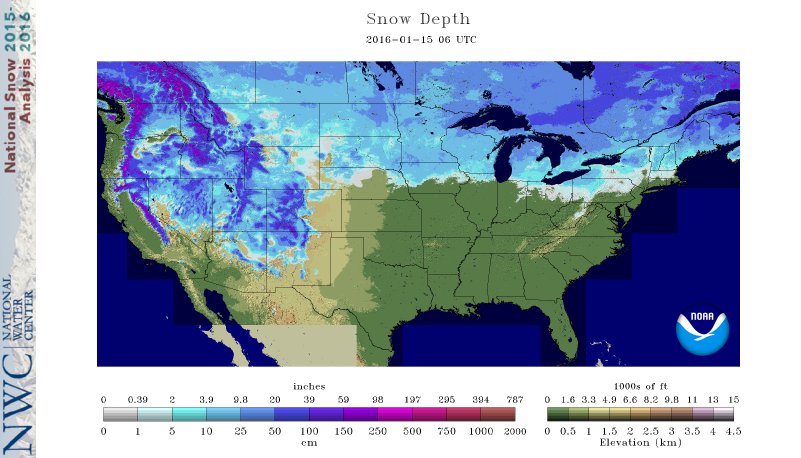Climate Data Source Reference
The data sources that are collected, interpolated and delivered through the ORMGP web portal are described in chronological order. For the most part, the most recent datasets supersede the oldest.
- Precipitation, Rainfall and Snowfall
- Snowmelt and SWE
- Air Temperature
- Atmospheric Pressure
- Relative Humidity
- Wind Speed and Direction
- Pan Evaporation
Precipitation, Rainfall and Snowfall
Meteorological Service of Canada
Meteorological Service of Canada is a division of Environment Canada. Their online historical data portal provides data collected since the mid-19th century. Precipitation is offered as rainfall and snowfall amounts to the tenth of a millimetre.
ECCC: Regional Deterministic Precipitation Analysis (RDPA)
Versions
Below lists the versions used, a complete changelog can be found here. The most recent version always takes precedence.
CaPA-RDPA version 1—experimental (2002—2012)
The hind-cast “experimental”/”pre-operational” version 1 of CaPA-RDPA, comes in a ~15km resolution.
CaPA-RDPA version version 2.4 (2011—2016)
Version 2.4 brings a number of improvements by incorporating more ground-truthing and refining to a ~10km resolution.
CaPA-RDPA version versions 4+ and 5+ (2015—2024)
Further improvements, still at a ~10km resolution.
CaPA-HRDPA (2019—present)
The latest iteration of CaPA is the High Resolution Deterministic Precipitation Analysis (CaPA-HRDPA) refined to a ~2.5km resolution.
Missing Dates
The CaPA RDPA products used have periods where no data exists. Listed below are the dates found. Where no data are found, the API reports the data interpolated from MSC point locations.
| CaPA-RDPA | CaPA-HRDPA |
|---|---|
| 2001-12-30 | 2019-12-14 |
| 2001-12-31 | 2019-12-15 |
| 2002-01-01 | 2019-12-16 |
| 2006-04-27 | 2019-12-17 |
| 2006-04-30 | 2021-01-01 |
| 2006-07-10 | 2022-01-01 |
| 2008-04-15 | 2022-06-20 |
| 2019-09-26 | |
| 2019-09-27 | |
| 2019-10-25 | |
| 2020-03-16 | |
| 2020-03-17 | |
| 2020-04-21 | |
| 2020-04-22 | |
| 2020-10-01 | |
| 2020-10-02 |
Snowmelt and SWE
U.S. National Oceanic and Atmospheric Administration (NOAA)
SNODAS daily (2010—present)
Snow water equivalent (SWE) and snowmelt must be derived from snowpack ablation models. These models come in a variety of forms and sophistication. The primary source of such information comes from the Snow Data Assimilation System (SNODAS) system (NOHRSC, 2004), which offers ~1 km gridded 24-hour (UTC 06-06) snowmelt totals, published freely in near real-time. The advantage of SNODAS is that we can avoid the need to model snowmelt explicitly, and leverage existing resources. The data cover our jurisdiction from 2009-12-09—present.
SNODAS 6-hourly (2020—present)
SNODAS is also offered in 6-hourly states, however it is offered only for the past month, so some automated web-scraping would be required. Here, the ORMGP-FEWS system imports and crops the data nightly.

Cold Content Energy Balance Snowpack Model
(1901—present)
When unavailable (and prior to 2010), a cold content energy balance snowpack model is applied relying on interpolated precipitation and temperatures.
Air Temperature
Elevations within the ORMGP region range from 75 to 400 m ASL and thus orographic effects to temperatures were deemed negligible. The spatial distribution of minimum/maximum daily temperature is interpolated from meteorological stations using an inverse squared-distance methodology.
All temperature data are acquired from the Meteorological Service of Canada.
Meteorological Service of Canada
Minimum and Maximum daily Temperature (1901—present)
Hourlies (1953—present)
Atmospheric Pressure
Meteorological Service of Canada
Hourlies (1953—present)
Atmospheric pressure data are acquired from Meteorological Service of Canada and come in hourly averages. In contrast to temperatures, elevation does have an impact on pressure distribution and thus corrections are made. Once corrected, the hourly data are aggregated to daily averages.
Relative Humidity
Meteorological Service of Canada
Hourlies (1953—present)
Relative humidity data are acquired from Meteorological Service of Canada
Wind Speed and Direction
Meteorological Service of Canada
Hourlies (1953—present)
Wind speed and direction data are acquired from Meteorological Service of Canada
